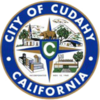Cudahy, California
| Cudahy, California | |||||
|---|---|---|---|---|---|
| City | |||||
| City of Cudahy | |||||
|
|||||
 Location of Cudahy in Los Angeles County, California |
|||||
| Location in the United States | |||||
| Coordinates: 33°57′51″N 118°10′57″W / 33.96417°N 118.18250°WCoordinates: 33°57′51″N 118°10′57″W / 33.96417°N 118.18250°W | |||||
| Country | |||||
| State |
|
||||
| County |
|
||||
| Incorporated | November 10, 1960 | ||||
| Area | |||||
| • Total | 1.226 sq mi (3.175 km2) | ||||
| • Land | 1.175 sq mi (3.043 km2) | ||||
| • Water | 0.051 sq mi (0.132 km2) 4.15% | ||||
| Elevation | 121 ft (37 m) | ||||
| Population (April 1, 2010) | |||||
| • Total | 23,805 | ||||
| • Estimate (2013) | 24,103 | ||||
| • Density | 19,000/sq mi (7,500/km2) | ||||
| Time zone | PST (UTC-8) | ||||
| • Summer (DST) | PDT (UTC-7) | ||||
| ZIP Code | 90201 | ||||
| Area code(s) | 323 | ||||
| FIPS code | 06-17498 | ||||
| GNIS feature ID | 1652694 | ||||
| Website | www |
||||
Cudahy (/ˈkʌdəheɪ/ KUD-ə-hay) is a city located in southeastern Los Angeles County, California. In terms of area, Cudahy is the second smallest city in Los Angeles County, after Hawaiian Gardens, but with one of the highest population densities of any incorporated city in the United States. It is part of the Gateway Cities region. Cudahy is populated predominantly by Latino immigrants and has a population of 23,805 as of the 2010 U.S. Census.
Cudahy is named for its founder, meat-packing baron Michael Cudahy, who purchased the original 2,777 acres (11.2 km2) of Rancho San Antonio in 1908 to resell as 1-acre (4,000 m2) lots. These "Cudahy lots" were notable for their dimensions—in most cases, 50 to 100 feet (15 to 30 m) in width and 600 to 800 feet (183 to 244 m) in depth, a length equivalent to a city block or more in most American towns. Such parcels, often referred to as "railroad lots", were intended to allow the new town's residents to keep a large vegetable garden, a grove of fruit trees (usually citrus), and a chicken coop or horse stable. This arrangement, popular in the towns along the lower Los Angeles and San Gabriel rivers, proved particularly attractive to the Southerners and Midwesterners who were leaving their struggling farms in droves in the 1910s and 1920s to start new lives in Southern California. Sam Quinones of the Los Angeles Times said that the large, narrow parcels of land gave Cudahy Acres a "rural feel in an increasingly urban swath." As late as the 1950s, some Cudahy residents were still riding into the city's downtown areas on horseback. After World War II the city was a White American blue collar town with steel and automobile plants in the area.
...
Wikipedia




